Anti-tank rifle grenades in World War II
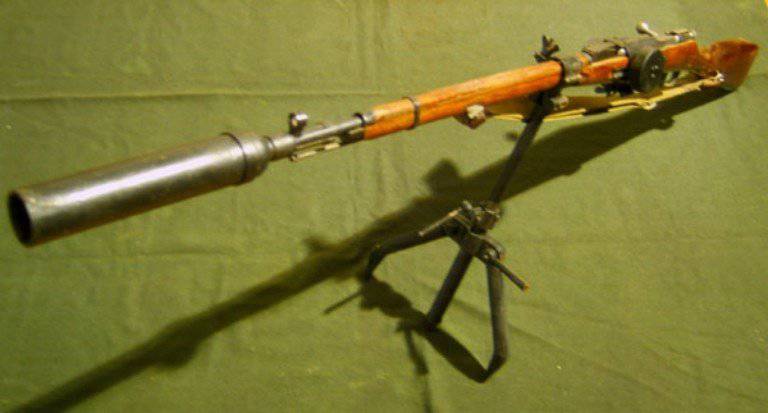
In 20-30-ies. The Red Army was armed with a Dyakonov grenade launcher. This grenade launcher was created at the end of the First World War and later modernized. Dyakonov's grenade launcher consisted of a mortar, a quadrant sight and a bipod. It was used to destroy the enemy manpower with a fragmentation grenade. The barrel of the 41 mm mortar barrel had three screw threads. She was rigidly fastened in a cup that was screwed on the neck. That, in turn, was put on the barrel of the rifle and was fixed on the front sight of the notch. Before WWII, a grenade launcher was in service in every cavalry and rifle squadron. At the same time, the question arose of imparting anti-tank properties to this grenade launcher. During the war, the VKG-40 grenade was adopted. Her body had a streamlined shape, on the cylindrical part of the three leading protrusion. In the tail section, conical in shape, a bottom fuse was mounted, which included an inertial body (“settling cylinder”), a blasting cap, a wire slip and an additional detonator. The bottom of the cap was closed. The length of the VKG-40 grenade was 144 mm. For shooting grenades used a special blank cartridge with an 2,75-gram charge of powder brand P-45 or VP. Dulce cartridge sleeve crimped with an asterisk and stained black, like the head of a grenade. The mortar was also modernized: a special front sight with a fence was fixed on the neck, a screw screwed into the barrel, limited the advancement of grenades during dispatching. The reduced charge of the cartridge made it possible to shoot direct fire, while the butt rested on the shoulder. They fired without a bipod, using a rifle sight: the mark “16” - range to 50 m, “18” - to 100 m, “20” - to 150 m. The total weight of the rifle with mortar was 6 kilograms. Such a “grenade launcher” was serviced by one person (here, in contrast to the use of a fragmentation grenade, it was not necessary to put up the phone before loading). Rate of fire - up to 6 shots per minute. VKG-40 was used very limitedly. This is due to the low accuracy of shooting and the underestimation of the rifle grenade launcher. However, later, the VG-44 and VG-45 rifle anti-tank grenades were taken into service for the carbines.
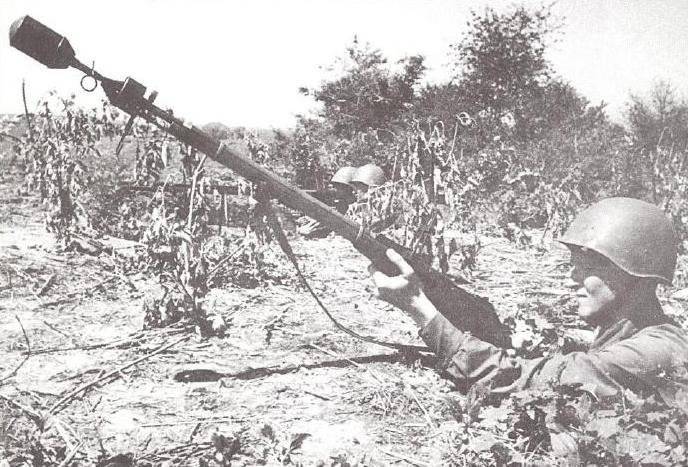
At the beginning of 1942, the VPGS-41 ramrod (“Serdyuk rifle anti-tank grenade of the 1941 model of the year”), created in the design bureau of the People's Commissariat of the Coal Industry, headed by Serdyuk, was adopted. VPGS-41 consisted of a streamlined body in which a shaped charge was placed, a fuse and a "ramrod" tail, which was inserted into the rifle barrel. A clip with a stabilizer was put on a ramrod with an obturating groove. When inserting the ramrod, the stabilizer pressed against the body. After the grenade took off, the stabilizer was fixed at the rear end of the ramrod. A blank cartridge was used for the shot. The direct fire range was up to 60 meters, and at an elevation angle of 40 degrees - up to 170 meters (this method of firing was used to destroy stationary clusters of equipment). During the battle near Moscow, VPGS played a role - it was produced by the Moscow factories "Red Torch" and "Red Proletarian". The effective range and accuracy were not high, quite often the fuse worked prematurely. In addition, "ramrods" very quickly spoiled the rifle barrel. In this regard, the grenade, which was initially ordered in large quantities, was already removed from service and production in 1942.
Their grenade launchers were in service with the partisan detachments. For example, a very successful mortar in 1943 was developed by TE Shavgulidze, fighter of the Minsk partisan unit. For her, he used 45-mm cartridge shells, anti-tank grenades and a high-explosive frag grenade.

At the end of World War I, the British Army was supposed to use a high-explosive ramrod rifle grenade no. 44 with a head shock fuse against a few German tanks. Grenade except for the ramrod-tail had a ring stabilizer, which provided the best accuracy and correct fall. However, evidence of the use of this grenade against the tanks was not found.
During the Second World War, the British used a 51-mm muzzle-loading smooth-bore rifle grenade launcher (mortar) against tanks and armored vehicles. Initially, it was assumed that the Mils hand grenade would be fired from this grenade launcher. In 1940, grenade No. 68 appeared, which had a steel cylindrical body with a shaped charge (covered with a flat lid), a bottom inertial fuse, a detonator cap and an igniter cap.
Armor penetration - up to 50 mm. There was a four-bladed stabilizer in the tail section of the hull. The hull was painted yellow-brown with green and red belts. A blank cartridge was used for the shot. As a rule, they shot from the prone position. The fuse check was removed before the shot. The maximum firing range is 100 yards (91 m), the greatest efficiency was achieved at a distance of 45-75 m. Grenade No. 68 was used in France in 1940 to a limited extent. In 1941-1942, it was mainly issued to the Home Guard (local defense). A light 51mm mortar was also used for the shot.
In the United States Army during the war, a system of rifle grenades was formed, which included anti-personnel, anti-tank, smoke and training samples. There were no mortars - all grenades were supplied with stabilizer tubes, which were mounted on a "throwing device" - a muzzle on the barrel of a rifle or carbine. The grenades were fired with the appropriate blank cartridges. The M9A1 anti-tank grenade had a streamlined body that housed a cumulative warhead, a stabilizer tube equipped with an annular stabilizer and an inertial bottom fuse. The length of the grenade was 284 millimeters, with a body diameter of 51 millimeters. The initial speed during firing from a carbine was 45 meters per second, with a range of up to 175 meters, from a rifle - 55 meters per second, a range of up to 250 meters. However, the accuracy of fire made it possible to effectively destroy armored targets at a much shorter distance. The American Marines successfully used such grenades in 1944 on the islands of the Pacific region against Japanese lightly armored tanks - the benefit of the thickets and the terrain allowed them to shoot almost point-blank. For training, they used the M11-A2 training grenade, which repeated the M9A1 in shape, weight and size. Feathered rifle grenades, which were fired from a flash hider or from a small muzzle attachment, turned out to be a more promising direction for the development of this type of ammunition. In the United States, at the beginning of the war, a variant of a rocket-propelled anti-tank grenade using a rifle bayonet as a guide was considered, but it was rejected.

The German Schiessbecher grenade launcher was a 30-mm rifled muzzle-loading mortar weighing 835 g. The barrel was screwed into a cup, which smoothly passed into the neck. The mortar was put on the barrel of a carbine or rifle and fastened with a clamping device. The sight was attached with a clip with a screw in front of the receiver on the left. Its swinging part had a sighting bar with a front sight and entirely at the ends, a level and a sector rear part with divisions from 0 to 250 m in increments of 50. The mass of the grenade launcher on the Mauser 98k carbine was 5,12 kg, the length was 1,25 m. The grenades had grooves, which, during loading, were combined with the grooves of the mortar.
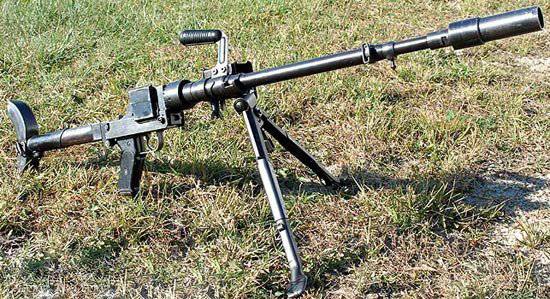
Caliber G.Pz.gr. ("small armor-piercing grenade") had an ogive-cylindrical body. On the tail section - ready-made rifling. The cumulative charge was covered by a ballistic cap. For undermining, a bottom inertial fuse was used through a detonator cap. There was also an additional detonator. The length of the grenade was 163 millimeters. The hull was painted black. The grenade was fired with a cartridge having a 1,1 g charge of gunpowder, a wooden wad and a ring around the primer. The firing range ranged from 50 to 125 meters at an initial speed of 50 m/s.
With the outbreak of hostilities against the USSR, in order to increase the "armor-piercing" properties of the grenade launcher, Gr.G.Pz.gr ("large armor-piercing grenade") was adopted. It was an over-caliber grenade with a thickened front and a long "stalk" that had a threaded sleeve (made of aluminum or plastic) at the back. The stem was inserted into the mortar. The inertial bottom fuse was cocked after the shot. The length of the grenade was 185 mm with a diameter of 45 mm. At a meeting angle of less than 60 degrees, the grenade pierced 40 mm armor. The hull was painted black. For the shot, a cartridge with a 1,9-gram charge of gunpowder and a wad (wooden bullet) was used. The initial speed was 50 meters per second. Despite the high armor penetration, the grenade had a very low accuracy. In this regard, shooting at stationary targets was carried out at a distance of up to 100 m, at moving targets - up to 75 m. When shooting with an ordinary cartridge from a rifle with a mortar, some excess of sight was taken. Each infantry, tank destroyer and sapper company was armed with 12 mortars, field batteries - two each. Each mortar was relied on 20 "armor-piercing" and 30 fragmentation grenades. However, in the Wehrmacht, as in the Red Army, anti-tank rifle grenades were used little, since "the impact of a rifle grenade on the internal equipment of the tank and the crew was insignificant" (E. Middeldorf).
By the end of 1941, the inefficiency of the 7,92-mm PTR PZ.B.-39 became clear, therefore, in 1942, the Granatbuche 39 anti-tank grenade launcher (Gr.B.-39) was created on its basis. The barrel was shortened to 595-618 millimeters, the breech was simplified, the handguard was removed, and a 30-mm rifled mortar was installed at the end of the barrel. Her cup was screwed onto the PTR barrel. The mass of the mortar was 800 grams, length - 130 mm. Sights included rear and front sights. The rear sight was mounted in the groove of the receiver on the bracket. The front sight, which was a grid consisting of six horizontal threads and one vertical thread, was attached to the breech of the barrel with a clip. A range of up to 150 meters in increments of 25 was marked with horizontal threads, aiming crosshairs were formed with a vertical thread. A casing with a shield having three holes was attached to the frame of the sight. The middle hole served in the dark as an auxiliary front sight (75 m). Aiming at the tanks was carried out along the lower edge of the tower or in its middle. When the target is moving - with the removal of 0,5 - 1 machine body. Shooting at stationary targets was carried out at a distance of up to 150 m, at moving ones - up to 75 m. The combat crew consisted of 10,5 people. Shooting was carried out by "Gr.G.Pz.gr." having a reinforced stem and “improved rifling” or a special Gr.G.Pz.gr.908 “large armor-piercing grenade of the 1230 model”. The latter had a teardrop shape, great strength, a strong charge, and a fuse that worked at any angle of the meeting. The length of Gr.G.Pz.gr.2 was 61 mm, with a case diameter of 1943 mm. The stalk of the pomegranate had a light brown color. The grenade was fired only from the Gr.B-61. For the shot, a Pz.B.-195 cartridge case with a wooden bullet was used. The initial speed of the shot is 46 meters per second. For firing grenade Gr.G.Pz.gr. (Gr.G.Pz.gr.39) used a "throwing" cartridge, created on the basis of the "39" cartridge and having an enhanced powder charge. Shooting unreinforced "large" or "small" grenades was not allowed, as they could collapse during the shot. This grenade launcher, like other rifled "rifle mortars", has a significant drawback - inserting a grenade from the muzzle and baggy loading. This significantly reduced the practical rate of fire, as well as the survivability of weapons in close combat.
The desire to use any means as a combat tool led to the creation of a grenade for pistols. For example, in Germany, an anti-tank shot "Wurfgranatpatron 326 HL / LP" of an over-caliber grenade with armor penetration of 50 mm was developed specifically for a signal pistol. However, due to low accuracy, this cheap and simple tool has not been widely used. The use of a rifled (5 grooves in the bore) signal "Kampfpistole Z" created in the late 30s on the basis of the signal smoothbore "Walter" of the 1934 model seemed to be a more successful solution. The mass of such a "pistol" was 745 g, length - 245 mm, barrel length - 155 mm. The pistol was turned into a grenade launcher by attaching a folding sight and a metal butt. The mass of the grenade launcher is 1960. The anti-tank shot "Wurfgranatpatron H62LP" was a modification of the PWM-1 hand-held cumulative grenade. However, after a shot at a distance of more than 30 m, she began to tumble. The Panzerwurfkorper 42 LP anti-tank grenade developed in 1942 proved to be the most successful. This grenade consisted of a drop-shaped body with a painful charge (a mixture of RDX and TNT) and a bottom inertial fuse, as well as a rod with ready-made rifling at the end. The rod contained an igniter cap, an expelling charge of porous pyroxylin powder and a piston, which, when fired, cut off the connecting pin and threw out the grenade. The length of the grenade was 305 millimeters, and the largest diameter was 61 millimeters. The firing range of the "Z" pistol was 50 meters. For firing from a signal pistol, an insert rifled barrel was used.
Anti-tank rifle feathered grenades with a cumulative warhead were actively developed for the first twenty years after the war (Belgian Energa, French Mle 50 and 61, Spanish GL61 and American M-31). However, at the end of the 60s, the growth of armor protection of tanks brought these grenades out of the number of anti-tank weapons. However, it remained possible to use them against shelters and light armored vehicles. It is no coincidence that in the designations of these grenades, the abbreviation "AT" (anti-tank) was replaced by "AR" (armor penetrative - "armor-piercing"), while the cumulative warhead was replaced with a cumulative fragmentation.
The source of information:
The magazine "Equipment and weapons" Semen Fedoseev "Infantry against tanks"
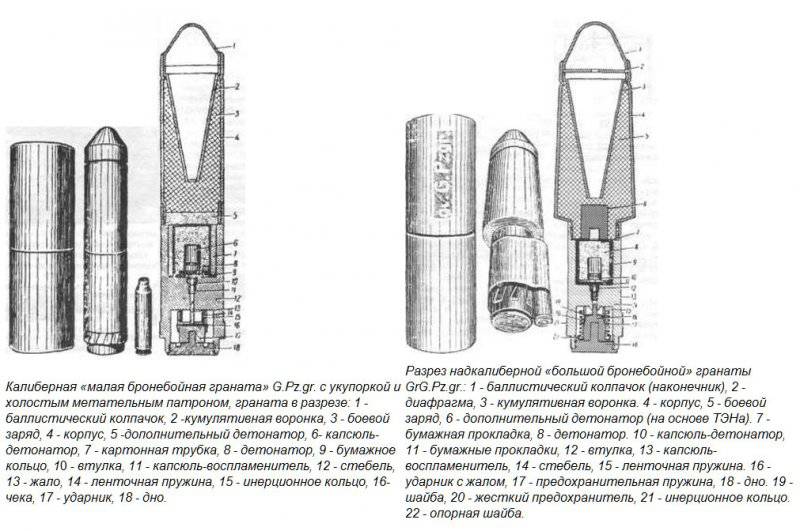
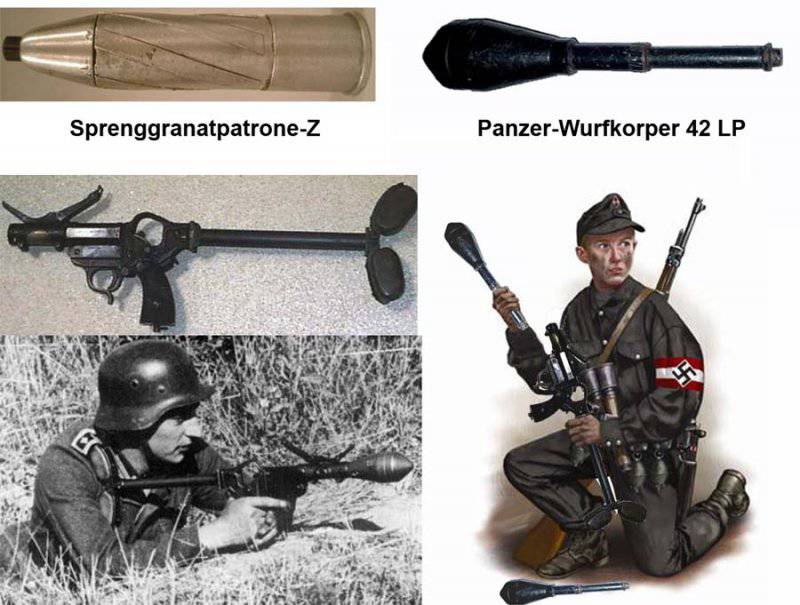

Information